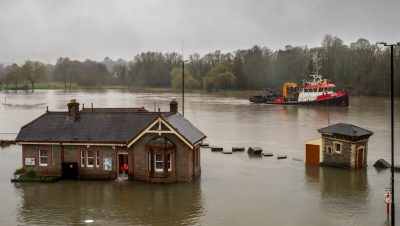
Features / marine biology
Changing the Soundtrack of the Ocean: a blueprint for marine recovery
Once thought silent, the sea is alive with sound.
For centuries, the ocean was imagined as quiet.
Jacques Cousteau’s 1956 documentary, Le Monde du Silence – The Silent World, etched the myth into public imagination.
is needed now More than ever
However, as scientists now stress, the sea has never been silent. It is alive with clicks, whistles, grunts and choruses – a hidden soundtrack.
By the end of the Cold War, the military had already learned the sea was alive with noise.
Using hydrophones to detect submarines, naval researchers discovered “biological noise” – a nuisance for defense, but a revelation for marine biology.

Professor Simpson’s presentation explored how underwater soundscapes are crucial for marine life
On Thursday, at the Hen & Chicken in Southville, professor Steve Simpson, a marine biologist from the University of Bristol, described how sound shapes life beneath the waves in a discussion chaired by Miranda Krestovnikoff, a broadcaster and vice president of the Royal Society for the Protection of Birds.
His presentation, Changing the Soundtrack of the Ocean, explored how underwater soundscapes are crucial for marine life and how cutting-edge research is being used to restore damaged reefs.
Professor Simpson acknowledged indigenous stewardship of the lands and waters where his research takes place.
He specifically thanked the Dingal people of Lizard Island, the Boccolano people of Bool in the Philippines, the Tahitian people of Mara and the Madivian people of Lhaviyani and Baa Atolls.
Simpson has spent almost 30 years listening to the ocean and his work has revealed what he describes as the marine equivalent of a forest’s dawn chorus.
At sunrise, the fish emerge and stake out territories.
At dusk, nocturnal species call each other as they forage.
Whales, dolphins, snapping shrimp and countless fish add their voices to what Simpson called the “bioacoustic hotspots” of coral reefs.
Yet, these soundscapes are more than curiosities.
They are vital cues for survival.
Fish larvae drifting at sea use them to find their back to reefs.
Corals, crabs and lobsters are drawn to them when choosing habitats.
Even the hair-like sensors on coral larvae function like the human ear, tuned to specific frequencies that guide them home.
When corals bleach and die, however, these soundscapes fall silent, disrupting the life cycles of countless species.
“If sound is of the cues that tells fish where to live,” Simpson warned, “then silence means those habitats stop replenishing.”
The silencing of reefs is one of the symptoms of the climate emergency.
The mass bleaching of the Great Barrier Reef in 2016, triggered by rising sea temperatures, underscored how fragile and vulnerable even the most protected ecosystems have become.
One of those solutions lies in using sound itself as a tool for discovery.
In the Maldives, researchers collect coral eggs during spawning, nurture them in protective tanks and return them to degraded reefs – sometimes accompanied by recordings of healthy reef soundscapes.
The technique, dubbed “acoustic anchoring”, encourages larvae to settle and begin rebuilding lost habitats.
Similar methods are being tested with fish.
Recordings of vibrant reefs can attract fish back to damaged areas, while conditioning juveniles with sound during growth may improve their survival when released.
The Hope Reef project in Sulawesi demonstrated restoration at unprecedented scale, Simpson explained, with artificial reef structure spelling out ‘HOPE’ across several football pitches.
These stabilised habitats lift corals above rubble fields, providing clean water and stable surfaces for growth.
The project’s success is measured partly through the return of breeding fish populations whose larvae can recolonise larger areas.
The battle also involves reducing human-made noise that now pervades the oceans.
Boat engines, scuba divers and industrial activity disrupt feeding and parenting behaviours, sometimes with devastating results.
In one case, noise was found to cause reef fish parents to abandon or even eat their young. However, here too, there are signs of progress.
“Acoustic sanctuaries”, areas where noisy activities are kept at bay, are being trailed in the Maldives.
On the Great Barrier Reef, restrictions on boating near nesting grounds boosted reproductive success in spiny chromis fish by 40 per cent.
Postmodern technology enables continuous monitoring of marine environments worldwide.
AI algorithms can process multiple live streams simultaneously, detecting everything from migration patterns to illegal fishing activities.
Shipping lanes can be dynamically adjusted to avoid migrating whales, reducing both deadly collisions and noise pollution that masks whale communication.
The pandemic provided an unexpected natural experiment in ocean quieting.
Reduced shipping and tourism allowed researchers to hear whale songs that had been masked for decades.
In California, blue whales returned to sing near shore when ships were required to use cleaner fuel, creating an acoustic sanctuary purely through maritime regulation.
As AI advances, scientists are approaching the ability to decode animal languages.
Recent work has produced ‘subtitles’ for clownfish interactions, revealing their complex social dynamics.
Yet, this capability raises profound questions about whether humans should attempt to communicate with marine species.
Researchers emphasise caution, noting that poorly executed attempts at interspecies communication could be disruptive to animals as off-key musicians are to human audiences.
If such communication develops, it must be approached with clear scientific purposes and rigorous ethical oversight.
The WOPAM (World Ocean Passive Acoustic Monitoring) community invites anyone to become a recorder, taking acoustic snapshots of local aquatic environments on World Ocean Day.
This global coordination creates unprecedented datasets for understanding ocean health changes over time.
Individual action can contribute meaningfully through projects like seagrass restoration, which rely on volunteer seed collection.
These meadows capture carbon 35 times faster than tropical rainforests and provide critical habitat for species like seahorses.
Citizen science apps allow coastal visitors to map seagrass meadows worldwide, building databases essential protection efforts.
Eco-anxiety is not abnormal, the Royal College of Psychiatry has argued, but an awakening can spur collective action.
Many of professor Simpson’s students, he noted, are determined to use science to find solutions rather than succumb to despair.
Professor Simpson recognised that the barriers to marine conservation are primarily economic and political rather than technological, making these fundamentally human problems with human solutions.
As we develop unprecedented ability to listen to marine environments, we gain equally unprecedented opportunities to understand, monitor and protect these critical ecosystems.
The ocean has never been silent. We just haven’t been listening carefully enough.
But science alone may not be enough to save the seas.
Simpson is acutely aware of the need to connect data with human stories and emotion.
A collaboration with conductor David Temple and composer Cassie transformed underwater recordings into a symphony that charted creation, destruction and hope.
Paraphrasing Jane Goodall, Simpson remarked: “We can often get far too caught up in data. We actually live by stories and stories of hope are what will change the data of the future.”
Medha Ghosh is part of Bristol24/7’s Youth Climate Reporters scheme which aims to broaden the range of perspectives and stories we tell on environment issues. It is funded by Bristol City Council and our public and Better Business members.
All photos: Medha Ghosh
Read next:
 Our newsletters emailed directly to you
Our newsletters emailed directly to you



















